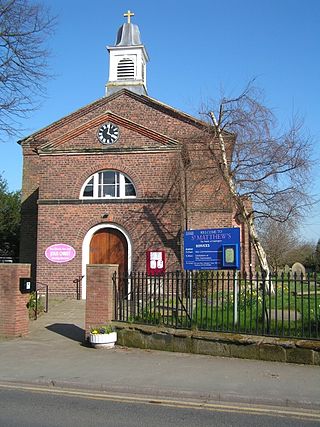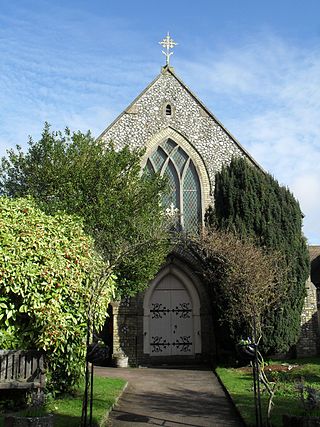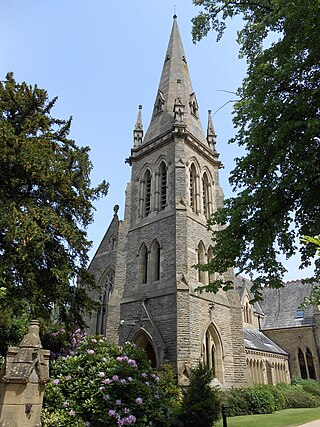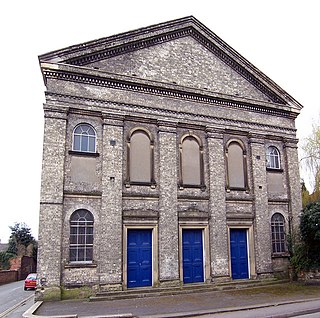
Capesthorne Hall is a country house near the village of Siddington, Cheshire, England. The house and its private chapel were built in the early 18th century, replacing an earlier hall and chapel nearby. They were built to Neoclassical designs by William Smith and (probably) his son Francis. Later in the 18th century, the house was extended by the addition of an orangery and a drawing room. In the 1830s the house was remodelled by Edward Blore; the work included the addition of an extension and a frontage in Jacobean style, and joining the central block to the service wings. In about 1837 the orangery was replaced by a large conservatory designed by Joseph Paxton. In 1861 the main part of the house was virtually destroyed by fire. It was rebuilt by Anthony Salvin, who generally followed Blore's designs but made modifications to the front, rebuilt the back of the house in Jacobean style, and altered the interior. There were further alterations later in the 19th century, including remodelling of the Saloon. During the Second World War the hall was used by the Red Cross, but subsequent deterioration prompted a restoration.

St Luke's Church is in the village of Holmes Chapel, Cheshire, England on the A50 road at its junction with the A535 road. The church is recorded in the National Heritage List for England as a designated Grade I listed building. It is an active Anglican parish church in the diocese of Chester, the archdeaconry of Macclesfield and the deanery of Congleton.

Woodhey Chapel is a Grade I listed private chapel off Woodhey Lane near Faddiley, Cheshire, England. The listing describes the building as 'A handsome and intact example of a chapel from a period when few were built'. The chapel, which is now disused, stands in fields near the site of the demolished Woodhey Hall. Its west end is connected to buildings of the former hall by a causeway which is raised by about 5 feet (2 m).

Poole is a civil parish in the unitary authority of Cheshire East and the ceremonial county of Cheshire, England, which lies to the north west of Nantwich and to the west of Crewe. The Shropshire Union Canal runs through the parish. Nearby villages include Acton, Aston juxta Mondrum, Barbridge, Stoke Bank, Rease Heath and Worleston.
Holy Trinity Chapel is a private chapel adjacent to Capesthorne Hall, near the village of Siddington, Cheshire, England. It is recorded in the National Heritage List for England as a designated Grade II* listed building. It is an Anglican church in the diocese of Chester, the archdeaconry of Macclesfield and the deanery of Macclesfield. Its benefice is combined with those of St James and St Paul, Marton, Christ Church, Eaton, and All Saints, Siddington.

St Matthew's Church is in the village of Haslington, Cheshire, England. The church is recorded in the National Heritage List for England as a designated Grade II listed building. It is an active Anglican parish church in the diocese of Chester, the archdeaconry of Macclesfield and the deanery of Nantwich. Its benefice is combined with that of St Michael and All Angels, Crewe Green.

The Wesleyan Methodist Church, also known as the Wesleyan Chapel, is a former Wesleyan Methodist church on Hospital Street, Nantwich, Cheshire, England. Built in 1808, a new façade was added in 1876. The church then seated over a thousand, and was the largest Nonconformist place of worship in the town in the 1880s. It is listed at grade II. The church closed in 2009, after the congregation moved to the former Methodist schoolrooms opposite.

Steyning Methodist Church is a Methodist place of worship serving Steyning and surrounding villages in the Horsham district of West Sussex, England. Built for a Wesleyan Methodist congregation who had outgrown an earlier chapel nearby, the Gothic Revival building opened in 1878 and has since been extended. The flint and yellow brick church is set back from Steyning's ancient High Street and is within the village conservation area. It is one of nine churches in the Worthing Methodist Circuit.

Robertsbridge United Reformed Church is a former United Reformed Church place of worship in Robertsbridge, a village in the district of Rother in the English county of East Sussex. Built for Congregational worshippers in 1881 following their secession from a long-established Wesleyan Methodist chapel, it was the third Nonconformist place of worship in the village, whose nearest parish church was in the neighbouring settlement of Salehurst. Like the former Strict Baptist and Methodist chapels in the village, which have both closed, it no longer serves Robertsbridge as a place of worship. Local architect Thomas Elworthy's distinctive design—a "rich" and highly decorated blend of several styles—has divided opinion amongst architectural historians. English Heritage has listed the church at Grade II for its architectural and historical importance.

The Methodist Church, Weaverham, was an active Methodist church located in Forest Street, Weaverham, Cheshire, England. It was in the Northwich and Winsford Circuit of the Chester and Stoke District. The church is recorded in the National Heritage List for England as a designated Grade II listed building.

St Mary's Church is in St Mary's Street, Crewe, Cheshire, England. It is an active Roman Catholic parish church in the diocese of Shrewsbury. The church is recorded in the National Heritage List for England as a designated Grade II listed building.

Preston Central Methodist Church is in Lune Street, Preston, Lancashire, England. It is an active Methodist church in the Preston Ribble Methodist Circuit, and the Lancashire district. The church is recorded in the National Heritage List for England as a designated Grade II listed building.

St Joseph's Church is in Skeffington Road, Preston, Lancashire, England. It is an active Roman Catholic church in the Diocese of Lancaster. The church is recorded in the National Heritage List for England as a designated Grade II listed building.

All Saints Church is in the village of Scholar Green in the parish of Odd Rode, Cheshire, England. It is an Anglican parish church in the deanery of Congleton, the archdeaconry of Macclesfield, and the diocese of Chester. The church is recorded in the National Heritage List for England as a designated Grade II* listed building.

Easton Methodist Church is a Methodist Church in Easton, on the Isle of Portland, Dorset, which was built in 1906–07. The church, along with its former manse and boundary walls, has been a Grade II* Listed since May 1993. Its church hall was formerly a Wesleyan school, dated 1878 on the porch. The school, with the boundary wall, was designated Grade II in May 1993. The church remains active to date, as part of the Portland Methodist Circuit – which involves two churches; Underhill Methodist Church and Easton Methodist Church.

Surface Hill Uniting Church is a heritage-listed former Uniting church at Channon Street, Surface Hill, Gympie, Gympie Region, Queensland, Australia. It was designed by architect Hugo William Du Rietz and built from 1869 to 1937. It is also known as City Church, Surface Hill Methodist Church and Wesleyan/Wesley Church. It was added to the Queensland Heritage Register on 30 May 2003.

St Paul's Methodist Church is a former Methodist church in the Manchester suburb of Didsbury. The building was designed by the architect H.H. Vale as a church for the nearby Wesleyan Theological Institution and opened in 1877. The building was converted into an office space in 1990. It is recorded in the National Heritage List for England as a designated Grade II listed building.

Tryon Road Uniting Church is a heritage-listed Uniting church located at 33 Tryon Road in the Sydney suburb of Lindfield in the Ku-ring-gai Council local government area of New South Wales, Australia. It was designed by William Slade and built in 1914 by W. 'Ossie' Knowles. It is also known as Lindfield Wesleyan Methodist Church. The property is owned by the Uniting Church in Australia. It was added to the New South Wales State Heritage Register on 19 September 2003.
Mawer and Ingle was a company of architectural sculptors, based in Leeds, West Yorkshire, England, between 1860 and 1871. It comprised cousins Charles Mawer and William Ingle (1828–1870), and Catherine Mawer (1804–1877) who was mother of Charles and aunt of William. The group produced carvings on many Gothic Revival churches and their internal furnishings. They also worked on civic buildings, warehouses and offices. Many of these are now listed by Historic England, and many of the surviving buildings are within Yorkshire. Their work outside Yorkshire included Trent Bridge.

Trinity Methodist Church is a mid 19th-century Methodist church and a Grade II Listed building in Barton-upon-Humber, North Lincolnshire, England.



















